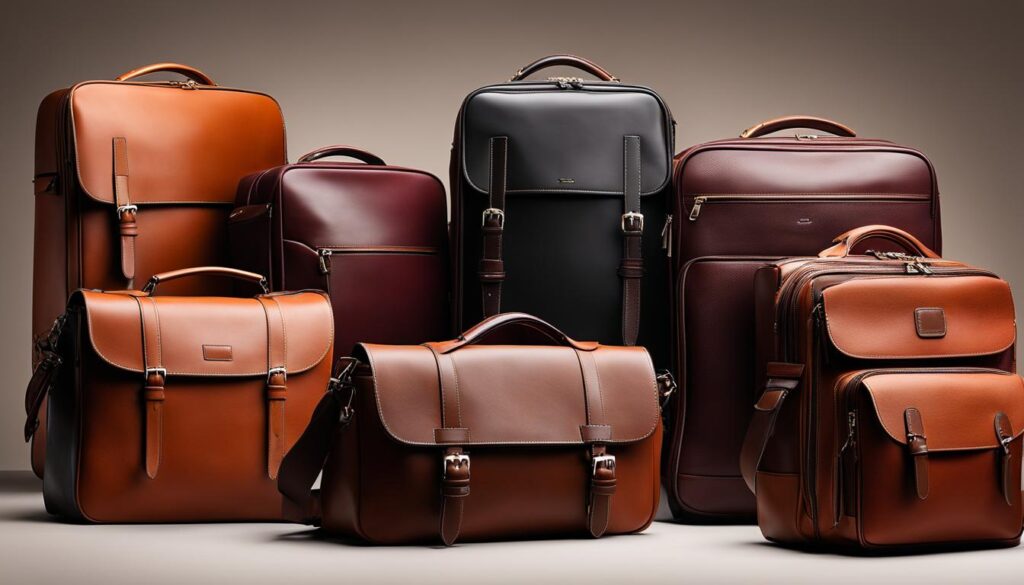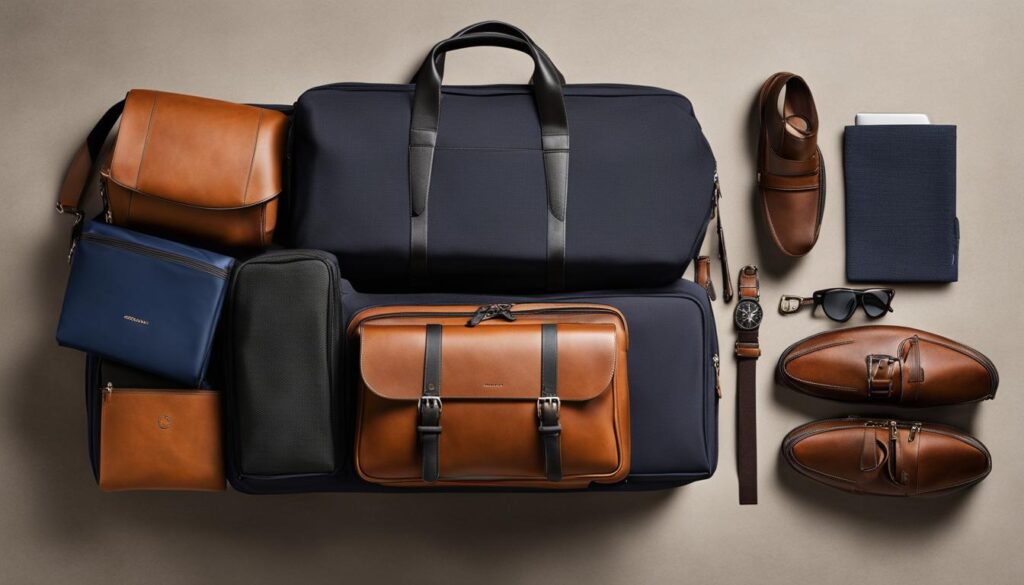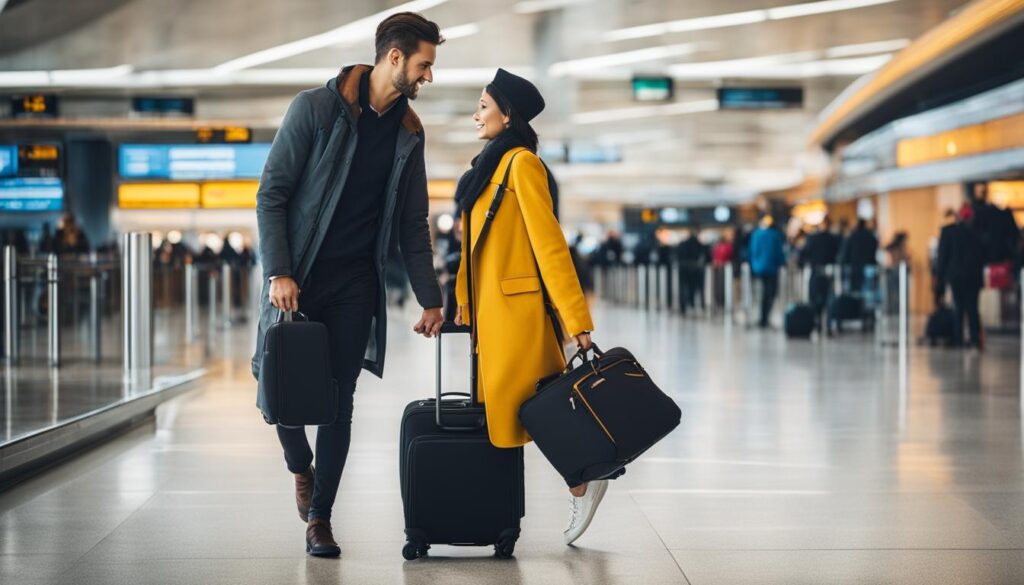When it comes to choosing the right travel bag for your trip, size matters. Airlines have specific size and dimension requirements for different types of luggage, and it’s important to comply with these regulations to avoid any issues at the airport. To help you navigate the world of travel bag sizes, we’ve put together the ultimate travel bag size guide. From hand baggage to carry-on luggage and checked bags ( Find your travel bag throug travelhourly.com ), this guide will break down the standard sizes and dimensions you need to know.
By understanding the dimensions and restrictions for each category, you can ensure that your travel bag meets the requirements and make packing a breeze. Let’s dive in!
Key Takeaways:
- Choosing the right travel bag size is essential for hassle-free packing.
- Airlines have specific size and dimension requirements for different types of luggage.
- Understanding the dimensions and restrictions for each category will help you select the right travel bag.
- Hand baggage, carry-on luggage, and checked bags all have different size limits.
- Complying with airline regulations will help you avoid any issues at the airport.
Understanding the Standard Sizes for Luggage
When it comes to travel, choosing the right luggage size is crucial to ensure a smooth and hassle-free journey. Airlines have specific weight and dimension requirements for all baggage items, including hand luggage, carry-on luggage, and checked luggage. By understanding these standard sizes and adhering to airline regulations, you can avoid any issues at the airport and make your travel experience much more convenient.
Most airlines have their own size standards for each category of luggage, but they generally fall within similar dimensions. It’s important to note that these dimensions may vary slightly from one airline to another, so it’s always a good idea to check with your specific airline for their requirements.
To give you a general idea, here is a comparison of the standard sizes for different types of luggage:
| Luggage Category | Dimensions (in inches) |
|---|---|
| Hand Luggage / Personal Items | 17x10x9 to 18x14x8 |
| Carry-On Luggage | 22x14x9 to 24x16x10 |
| Checked Luggage | Varies by airline (small: 24x17x10.5, medium: 27×18.5×14, large: 32x22x14) |
By owning at least one travel bag from each category, you can be prepared for any type of trip and ensure that your luggage meets the size requirements set by the airlines. Whether you prefer a compact carry-on or a spacious checked bag, it’s important to choose a bag that fits within the specific dimension limits and provides ample packing space for your belongings.
Remember, the size and weight restrictions for luggage can vary between airlines, so it’s always a good idea to check the guidelines provided by your specific airline. By understanding the standard sizes for luggage and adhering to airline regulations, you can have a stress-free travel experience and ensure that your luggage is ready for takeoff.
Hand Luggage or Personal Items
When it comes to traveling, having the right hand luggage or personal item bag is essential. These bags are designed to hold all your essential items and keep them easily accessible during your journey. Understanding the size limits for hand luggage is crucial to ensure a seamless travel experience. Most airlines have specific restrictions on the dimensions of hand luggage, so it’s important to choose a bag that falls within these size limits.
Typically, the size limits for hand luggage on domestic flights range from 17x10x9 inches to 18x14x8 inches. This allows for efficient storage in overhead compartments or under the seat in front of you. It’s important to note that these dimensions may vary slightly depending on the airline you’re flying with, so always double-check their specific requirements.
When selecting a hand luggage bag, prioritize both size and functionality. Look for a bag that offers ample packing space while still fitting within the airline’s size limits. Consider the different compartments and pockets available to keep your belongings organized. Opting for a bag with a durable and comfortable shoulder strap or handle will make navigating through airports a breeze. Remember, choosing the right hand luggage can make all the difference in your travel experience.
Benefits of Hand Luggage
Traveling with a suitable hand luggage bag offers numerous benefits. Firstly, having your essential items within reach during flights or road trips allows you to stay comfortable and entertained throughout the journey. Whether it’s a book, tablet, or travel documents, having them easily accessible in your hand luggage ensures you’re always prepared.
Additionally, using a hand luggage bag helps protect valuable items and prevent damage or loss. By keeping them with you at all times, you can avoid the risk of these items being mishandled or misplaced during baggage handling. Hand luggage bags also provide extra cargo space, allowing you to bring along items that may not fit in your checked luggage.
Overall, investing in a well-designed hand luggage bag that meets the size limits set by airlines is a smart choice for any traveler. It offers convenience, peace of mind, and easy access to your essentials throughout your journey.
Examples and Benefits of Hand Luggage
When it comes to hand luggage, there are a variety of options to choose from. These include larger purses, satchels, laptop bags, briefcases, small backpacks, and mini totes or duffels. The term “personal item” on airplanes has a wide definition and can even include items like umbrellas and coats. Traveling with a hand luggage bag offers several benefits that make it a popular choice among travelers.
One of the main benefits of hand luggage is having essential items within reach during flights or road trips. With a well-organized hand luggage bag, you can keep important documents, electronics, and personal items easily accessible throughout your journey. This is especially useful when you need to quickly retrieve items during security checks or in-flight. You won’t have to dig through a larger bag or worry about your belongings getting lost or damaged in the overhead compartment.
Traveling with hand luggage also allows you to protect valuable items. By keeping these items with you at all times, you can minimize the risk of them being lost, stolen, or damaged. It provides peace of mind, knowing that your important belongings are within sight and reach.
Additionally, choosing hand luggage can help you maximize free cargo space. Some airlines have limits on the number of carry-on bags allowed per passenger on board, but personal items such as hand luggage are often exempted from these restrictions. This means that you can bring both a carry-on bag and a personal item, giving you more space to pack essentials for your trip. It’s a smart packing strategy for those who prefer to travel light and avoid checked baggage fees.
In summary, hand luggage offers convenience, accessibility, and peace of mind during your travels. It allows you to have essential items within reach, protect valuable belongings, and make the most of your available packing space. Whether you opt for a sleek laptop bag or a versatile backpack, hand luggage is a practical choice for any traveler.
Carry-On Luggage for Easy Travel
When it comes to travel, having the right carry-on luggage can make your journey much easier and more convenient. Whether you’re going on a weekend getaway or a short business trip, a well-designed carry-on bag is essential. However, it’s important to be aware of the carry-on bag size restrictions set by airlines to ensure a hassle-free travel experience.
Carry-On Bag Size Restrictions
Each airline has its own guidelines for carry-on bag sizes, although they generally fall within similar dimensions. The typical range for carry-on bags is from 22x14x9 inches to 24x16x10 inches. It’s crucial to check your specific airline’s website for their carry-on luggage size and weight restrictions before you pack.
By choosing a carry-on bag that fits within these size restrictions, you can easily store it in the overhead compartment and avoid any issues at the airport. It’s also important to note that some airlines may have additional weight restrictions for carry-on bags, so make sure you’re aware of those as well.
Best Luggage Size for Travel
When selecting a carry-on bag, it’s essential to consider your travel needs and preferences. If you’re a minimalist packer or prefer to travel light, a smaller carry-on bag might be sufficient. However, if you need more packing space or tend to bring additional items, a slightly larger carry-on bag may be more suitable.
Keep in mind that the size of your carry-on bag should not only meet airline requirements but also be comfortable for you to handle and maneuver throughout your journey. Consider factors such as the bag’s weight, design features, and ease of transportation, such as wheels or backpack straps.
With the right carry-on luggage, you can enjoy the convenience and freedom of traveling with your essentials by your side. Remember to pack smart, follow the airline’s carry-on bag size restrictions, and choose a bag that suits your travel needs. Happy travels!
Examples and Benefits of Carry-On Luggage
Carry-on luggage comes in various forms, each offering its own advantages for travelers. Whether you prefer a duffel, roller suitcase, or backpack, choosing carry-on luggage allows you to enjoy several benefits during your journey.
Carry-On Bag Examples
| Type of Carry-On Bag | Features |
|---|---|
| Duffel | Spacious interior, easy-to-carry handles, versatile design |
| Roller Suitcase | Sturdy wheels, extendable handle, multiple compartments |
| Larger Backpack | Comfortable straps, padded laptop compartment, organization pockets |
| Roller Backpack | Wheels and handle for easy maneuvering, spacious interior |
| Zippered Tote | Stylish design, easy access to belongings, lightweight |
Traveling with carry-on luggage offers several benefits. Firstly, it allows you to avoid checked baggage fees. By packing strategically and efficiently, you can fit everything you need for your trip in a carry-on bag, saving you money and eliminating the hassle of waiting for your luggage at the baggage claim. Secondly, carrying your belongings with you ensures that they stay safe and secure throughout your journey. There’s no risk of lost or damaged luggage when everything is within your reach. Additionally, having a carry-on bag means you can have easy access to your essentials during the flight, eliminating the need to dig through a checked bag. Lastly, traveling light with a carry-on bag allows you to be more agile and flexible, easily moving through crowded airports and quickly transitioning between different modes of transportation.
So whether you prefer the convenience of a roller suitcase or the versatility of a backpack, choosing carry-on luggage gives you the freedom and flexibility to travel efficiently and enjoy your journey to the fullest.
Choosing Checked Luggage for Longer Trips
When planning for longer trips, it’s important to select the right checked luggage that suits your needs. Checked luggage refers to large bags that are checked in prior to your flight and stored in the airplane’s cargo compartment. These bags offer ample packing space and are ideal for vacations where you need to pack more outfits and essentials. While there are no standard dimensions for checked bags across all airlines, it’s important to consider the size limits set by your specific airline.
To help you choose the right checked luggage, refer to the table below for approximate size limits based on the general categories of small, medium, and large checked bags:
| Checked Bag Category | Approximate Size |
|---|---|
| Small Checked Bag | 24x17x10.5 inches |
| Medium Checked Bag | 27×18.5×14 inches |
| Large Checked Bag | 32x22x14 inches |
Please note that these dimensions are just an approximation and it’s always important to check your specific airline’s size and weight limits for checked luggage. Some airlines may have slightly different requirements, so it’s best to double-check beforehand to avoid any unexpected issues at the airport.
When it comes to choosing checked luggage, it’s also important to consider the features and durability of the bag. Look for bags with roller wheels or wide shoulder straps for easy transportation. Outer zipper compartments and inner mesh compartments can help with organization, while lightweight yet durable materials ensure that your belongings are protected throughout your journey.
Examples and Benefits of Checked Luggage
When it comes to choosing the right travel bag for longer trips, checked luggage offers a range of benefits. With its ample packing space, checked luggage allows you to bring all the essentials and more, ensuring you have everything you need during your vacation. Examples of checked luggage include roller suitcases and travel bags that are designed with features to enhance convenience and durability.
One example of checked luggage is the Samsonite Winfield 2 Hardside Luggage. This suitcase is made from durable polycarbonate material and features spinner wheels for easy maneuverability. It also has a fully lined interior with cross straps and a zippered divider to keep your belongings organized throughout your journey. Another example is the Delsey Helium Aero Expandable Spinner Trolley. This lightweight suitcase has a scratch-resistant exterior and double spinner wheels for smooth rolling. It also offers expandable packing capacity, allowing you to pack more items without compromising on weight restrictions.
The benefits of using checked luggage go beyond just the packing space it provides. By checking in your luggage, you can free up your hands during travel, making it easier to navigate through airports and other transportation hubs. You also don’t have to worry about carry-on restrictions or the hassle of storing your bag in the overhead compartment. Plus, with checked luggage, you can avoid the need to constantly lift and carry your bag, reducing the risk of strain or injury.
| Checked Luggage Examples | Benefits of Checked Luggage |
|---|---|
| Samsonite Winfield 2 Hardside Luggage | Ample packing space |
| Delsey Helium Aero Expandable Spinner Trolley | Free up hands during travel |
| Reduce risk of strain or injury |
The Shift to Carry-On Backpacks
Many frequent travelers have started using carry-on backpacks instead of suitcases due to the convenience and flexibility they offer. By using a carry-on backpack, you can avoid the risk of having your luggage soiled, broken, or lost when checked. Additionally, backpacks are often exempt from carry-on size restrictions enforced by airlines. This shift to carry-on backpacks ensures that travelers have control over their belongings and can easily navigate airports and other travel situations.
Carry-on backpacks are designed with travelers in mind, offering features like padded shoulder straps and a comfortable, ergonomic design. They are lightweight yet durable, making them ideal for both leisure and business travel. With multiple compartments and organization options, carry-on backpacks allow you to pack efficiently and keep your belongings easily accessible throughout your journey.
Not only are carry-on backpacks more convenient, but they also promote sustainable travel by reducing the need for disposable plastic bags and excessive luggage. With a carry-on backpack, you can pack smart, pack light, and optimize your travel experience. Say goodbye to long wait times at baggage carousels and the stress of potentially lost or delayed luggage. Embrace the shift to carry-on backpacks and make your next adventure hassle-free and enjoyable.
Choosing the Right Carry-On Backpack
When it comes to traveling light and staying organized, a carry-on backpack is an excellent choice. To ensure you select the perfect carry-on backpack for your needs, there are a few key factors to consider. Here are some features and size guidelines to keep in mind:
Size Requirements
When it comes to carry-on travel backpack size, it’s important to check the specific guidelines set by your airline. Generally, carry-on bags should be no larger than 22x14x9 inches to fit within the overhead compartments. However, it’s always a good idea to verify with your airline to avoid any surprises at the airport. Opting for a bag that falls within these dimensions will ensure a hassle-free travel experience.
Features to Look For
When choosing a carry-on backpack, it’s important to consider the features that will best suit your travel style. Look for backpacks with comfortable padded shoulder straps and a supportive back panel to ensure optimal comfort during your journey. Other convenient features include easy-access laptop compartments, multiple organizational pockets, and a checkpoint-friendly design that allows you to easily remove your laptop during security checks.
Additionally, consider the weight of the backpack itself. You’ll want to choose a lightweight option to maximize your overall weight allowance and avoid any unnecessary strain on your shoulders and back.
Recommended Carry-On Backpacks
There are several carry-on backpack options available on the market that combine functionality and style. Here are a few popular choices:
| Backpack | Dimensions (in inches) | Features |
|---|---|---|
| Tortuga 40L Travel Backpack | 22 x 14 x 9 | Durable, multiple pockets, laptop compartment |
| Osprey Farpoint 40/Fairview 40 | 21 x 14 x 9 | Lightweight, comfortable suspension system, spacious |
| Peak Design small and medium packing cubes | N/A | Modular packing system for easy organization |
These are just a few examples, and there are many other carry-on backpacks available to suit your personal preferences and travel needs.
When selecting a carry-on backpack, keep in mind the size requirements, desired features, and overall comfort. By choosing the right carry-on backpack for your travels, you’ll be able to enjoy the convenience, mobility, and organization it provides.
Packing Tips for Carry-On Travel
When it comes to traveling with just a carry-on bag, efficient packing is key. Follow these tips to make the most of your limited space and ensure a hassle-free journey:
1. Utilize Packing Cubes
Packing cubes are a game-changer when it comes to maximizing space and staying organized. These lightweight fabric bags come in various sizes and are perfect for separating your clothing items. Roll your clothes and place them neatly into the cubes to create more room and prevent wrinkles. You can even use different colored cubes for different types of clothes, making it easier to find what you need without unpacking your entire bag.
2. Pack Versatile Clothing
Instead of packing separate outfits for each day, opt for versatile clothing pieces that can be mixed and matched. Choose items that can be dressed up or down and can be layered for different weather conditions. This way, you can create multiple outfits with fewer clothing items, saving valuable space in your carry-on bag.
3. Use Compression Cubes
If you’re struggling to fit everything into your carry-on bag, consider using compression cubes. These handy bags allow you to compress your clothes, making them more compact and saving even more space. Simply place your rolled or folded clothes into the compression cube, seal it, and then compress it by rolling or pressing out the air. This technique can significantly reduce the volume of your clothing, allowing you to pack more efficiently.
4. Roll Clothing Items
Rolling your clothing items instead of folding them can save a significant amount of space in your carry-on bag. Not only does rolling prevent creases, but it also creates more room for other items. Start by rolling bulkier items like jeans and sweaters, and then tightly roll smaller items like t-shirts and underwear. Pack these rolls vertically in your bag to maximize space and make it easier to see and access your clothes.
By following these packing tips, you can make the most of your carry-on bag’s limited space and ensure a stress-free and efficient travel experience. Remember to pack only the essentials, check airline weight restrictions, and adjust your backpack straps for maximum comfort. Happy travels!
Conclusion
Choosing the right travel bag size is essential for hassle-free and efficient packing. By understanding the dimensions and restrictions for hand luggage, carry-on luggage, and checked luggage, you can ensure that your travel bag meets airline requirements and avoid any issues at the airport.
Whether you prefer a carry-on backpack or a suitcase, there are plenty of options available to suit your travel needs. Find your perfect travel bag through travelhourly.com, where you can compare different sizes, styles, and features. Remember to pack smart, pack light, and enjoy your journey!
FAQ
What are the standard sizes for hand luggage?
The typical size limits for hand luggage on most domestic flights range from 17x10x9 inches to 18x14x8 inches.
What can be considered as hand luggage or personal items?
Hand luggage can include larger purses, satchels, laptop bags, briefcases, small backpacks, and mini totes or duffels. The term “personal item” has a wide definition on airplanes and can include other items like umbrellas and coats.
What are the size restrictions for carry-on luggage?
Each airline sets its own guidelines for carry-on bag sizes, but they usually fall within the dimensions of 22x14x9 inches to 24x16x10 inches.
What are the benefits of traveling with carry-on luggage?
Traveling with a carry-on bag offers several benefits, including avoiding checked baggage fees, having extra packing space, and ensuring that your belongings stay with you throughout your journey.
What are the typical sizes for checked luggage?
Small checked bags are typically around 24x17x10.5 inches, medium checked bags around 27×18.5×14 inches, and large checked bags around 32x22x14 inches. It’s important to check your airline’s specific size and weight limits for checked luggage.
What types of bags can be used as checked luggage?
Checked luggage examples include roller suitcases and travel bags with features like roller wheels, wide shoulder straps, outer zipper compartments, inner mesh compartments, and durable yet lightweight materials.
Can carry-on backpacks be used instead of suitcases?
Yes, many frequent travelers have started using carry-on backpacks instead of suitcases due to the convenience and flexibility they offer.
What should I consider when choosing a carry-on backpack?
Size is the most important factor to consider when choosing a carry-on backpack. Each airline has its own guidelines for maximum allowable carry-on size, usually around 22x14x9 inches. It’s crucial to check your specific airline’s website for their carry-on luggage size and weight restrictions.
What are some packing tips for carry-on travel?
Utilize packing cubes to maximize space and keep your belongings organized. Pack versatile clothing pieces that can be mixed and matched, and consider using compression cubes to make clothes more compact. Learn how to roll clothing items instead of folding them to save space. Pack essentials in a toiletry bag that can be easily accessed during security checks. Follow airline weight restrictions and use a luggage scale if necessary. Lastly, ensure that your carry-on backpack fits comfortably and is properly adjusted to your body to prevent strain during travel.



